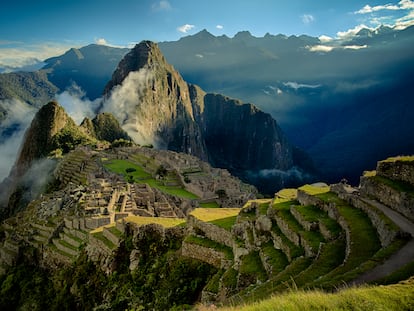The ‘Priest of Pacopampa’: Archaeologists discover 3,000-year-old tomb in the Peruvian highlands
The burial place found in the Cajamarca region contained offerings such as ceramic vessels and seals. The remains belong to one the first priests of ancient Peru

The ceremonial center of Pacopampa, located in the province of Chota in the mountain region of Cajamarca, hides treasures that continue to astonish the world. In 2009, a priestess was found in a boot-shaped tomb along with grave goods of earmuffs, gold earrings, and a seashell necklace. She was nicknamed the Lady of Pacopampa and would have lived in the year 900 B.C. In 2015, new finds at the site included two high-ranking figures: one of them wearing a necklace with 25 gold beads and various pigments of mineral origin. In August 2022, another discovery revealed a person who lived 3,000 years ago and who was buried with pututos, large seashells that were used as musical instruments.
One year later, the latest archaeological find unearthed on Peruvian soil is the Priest of Pacopampa, another high-ranking leader who would have lived ariund the year 1,000 B.C. during what is known as the Pacopampa I phase. It is presumed that he was one of the first priestly leaders of the temples in the region. This find and the others have been published by the Pacopampa Archaeological Project, who oversee the work of the Japanese researcher Yuji Seki and the Peruvians Daniel Morales, Elio Pérez, and Juan Pablo Villanueva, who have worked on the dig since 2005. These researchers have not stinted in their exploration of this site and have thus been able to tie up some of the loose ends in the research into ancient Peru.
There are several peculiarities of the Priest of Pacopampa: he was found in a tomb with a large circular hole of three meters in diameter and one meter deep with convex walls. The body, an adult, had open arms and crossed legs. He was lying face down. “In 43 years of research in Peru, it is the first time I have seen that position,” says Seki.

But not only was his posture striking, but he was buried with a succession of six layers of ash and black earth. As for the offerings, ceramic bowls with incised geometric designs have been unearthed, as well as seals that could be interpreted as painting techniques used in rituals for those who were part of the elite of their time. One of the seals features an anthropomorphic face looking to the east while the other has a jaguar design facing west. Another simply represents the five fingers of a hand. “We have never had so many seals in a single grave. Therefore, we are thinking that he was a very, very important person,” adds Seki.
The tomb also contained a pin made of bone called a tupu that was used to hold cloaks and ponchos. There were also deer bones as well as whole and broken ceramics. The Pacopampa archaeological complex, located at an altitude of 2,500 meters (8,202 feet) extends for 1.5 kilometers (0.9 miles) and is made up of nine carved and polished stone buildings. The Priest of Pacompapa was found in the area known as La Capilla (The Chapel).
The researchers maintain that this place was a pilgrimage center where ancient Peruvians from faraway places came to participate in sacred rituals. The discovery reaffirms how vital the Pacopampa Archaeological Project is, whose excavations are part of a binational project between the National University of San Marcos of Peru and the National Museum of Ethnology of Japan.
The joint venture is demanding that a Pacopampa Interpretation Center be constructed soon, which would help not only to understand the Andean civilization, but also to be a tourist focus. “There will be a complementary tour of the archaeological site,” says Judith Padilla, a representative of the Ministry of Culture. Therefore, how the site is managed by the Regional Government of Cajamarca and the Ministry of Foreign Trade and Tourism will be decisive.
Sign up for our weekly newsletter to get more English-language news coverage from EL PAÍS USA Edition
Tu suscripción se está usando en otro dispositivo
¿Quieres añadir otro usuario a tu suscripción?
Si continúas leyendo en este dispositivo, no se podrá leer en el otro.
FlechaTu suscripción se está usando en otro dispositivo y solo puedes acceder a EL PAÍS desde un dispositivo a la vez.
Si quieres compartir tu cuenta, cambia tu suscripción a la modalidad Premium, así podrás añadir otro usuario. Cada uno accederá con su propia cuenta de email, lo que os permitirá personalizar vuestra experiencia en EL PAÍS.
¿Tienes una suscripción de empresa? Accede aquí para contratar más cuentas.
En el caso de no saber quién está usando tu cuenta, te recomendamos cambiar tu contraseña aquí.
Si decides continuar compartiendo tu cuenta, este mensaje se mostrará en tu dispositivo y en el de la otra persona que está usando tu cuenta de forma indefinida, afectando a tu experiencia de lectura. Puedes consultar aquí los términos y condiciones de la suscripción digital.
More information
Destigmatizing coca: The sacred leaf reaches the culinary arts
Archived In
Últimas noticias
Most viewed
- Sinaloa Cartel war is taking its toll on Los Chapitos
- Oona Chaplin: ‘I told James Cameron that I was living in a treehouse and starting a permaculture project with a friend’
- Reinhard Genzel, Nobel laureate in physics: ‘One-minute videos will never give you the truth’
- Why the price of coffee has skyrocketed: from Brazilian plantations to specialty coffee houses
- Silver prices are going crazy: This is what’s fueling the rally










































